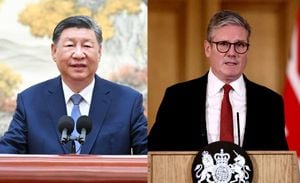At the United Nations Climate Change Conference (COP29) taking place this year in Baku, Azerbaijan, global leaders, scientists, and activists have gathered under the shadow of increasing climate crises and geopolitical tensions. This confab, notorious for being the stage where pivotal discussions on climate change emerge, faces unprecedented hurdles as the world grapples with extreme weather conditions and political instability.
The backdrop for this year’s COP29 is particularly tumultuous. While discussions shift from climate goals to immediate political realities, the discourse remains centered on pressing environmental concerns. The global temperature continues to rise, and alarmingly, global citizens are feeling the effects of climate change. Floods, heatwaves and hurricanes are becoming more frequent and devastating, with impacts felt far and wide—from coastal cities grappling with rising seas to inland areas struggling with intense droughts.
Leaders are gathering not only to address these pressing issues but also to reaffirm the commitments made under previous accords. With the effects of climate change becoming more pronounced each year, the need for decisive action is echoed repeatedly. Despite progress made at previous conferences, with countries pledging to limit their carbon emissions and invest heavily in renewable energy sources, critics assert these measures are insufficient.
This COP29 emphasizes the image of unity and collaboration against climate change. Still, geopolitical strife has made consensus even harder to achieve. Current leaders are not merely advocating for climate policies; they are also dealing with public sentiment back home and political narratives often skewed by the ramifications of climate action. The so-called ‘climate anxiety’ permeates communities worldwide as the younger generation increasingly demands accountability and substantial action.
Against this backdrop, the theme of COP29 is built on the necessity for sustainable solutions to combat the climate crisis. It aims to provide innovative frameworks for climate finance, technology transfers, and policy tools necessary for developing nations to adapt to climate impacts. The conference's objectives are numerous, but at the forefront remains the urgent need to reinvigorate international cooperation with concrete actions rather than rhetoric.
One of the strategies being discussed is enhancing the financing avenues for climate adaptation and disaster resilience. Many poorer countries, which lack the resources to combat the rampant effects of climate change, are advocating for greater support from wealthier nations. The financial resources necessary to implement these changes are considerable, and debates around the allocation of these funds are central to many discussions at COP29.
Interestingly, transportation and industry sectors are facing scrutiny as delegates deliberate on policies for limiting emissions. The push for transitioning to electric vehicles and sustainable practices is strong, but implementing widespread changes across different countries presents significant hurdles. Environmentalists argue the need for diversified energy sources, eschewing heavy reliance on fossil fuels, which many energy-dependent countries are hesitant to abandon due to economic repercussions.
Resistance toward abrupt shifts may also stem from economic dependencies and political rivalries surrounding energy resources. These countries, whose economies are intertwined with fossil fuel resource exploitation, are showing reluctance to embrace comprehensive climate policies. The tensions have paved the way for negotiations filled with conflicting interests, showcasing the delicate balance between economic growth and environmental sustainability.
Sessions dedicated to youth involvement have made waves, signaling recognition of the need to integrate younger voices and ideas. Young activists are not only participating as observers but have taken on more prominent roles at COP29, urging leaders to act decisively and deliver on the promises they so frequently make.
Importantly, the delegation from various nations is championing not just summit-level agreements but local actions and initiatives. Efforts at community levels are integral to achieving broader changes, with cities worldwide initiating local climate plans and embracing green technology. These localized responses serve as templates for responsible action against climate change, echoing the collaborative spirit of COP29.
Despite the underlying tensions, the conference serves as hope for many. With each passing year, it becomes clearer what is at stake, and COP29's agenda reflects this urgency. The leadership from Baku seeks to energize the dialogue surrounding climate finance, technology-sharing mechanisms, and forging new partnerships to address the mounting climate challenges.
Various documents produced at COP29 will outline aggressive targets for greenhouse gas emissions nationally and set ambitious expectations for how countries manage their carbon footprints. Observers remain hopeful; significant breakthroughs are possible, though questioned by many who have witnessed prior contradictions between commitments and actions.
The outcomes of COP29 could elucidate the ways forward for sustainable practices and lead to binding agreements on emission reductions. All eyes are on Baku as delegates engage through various sessions—from stakeholder roundtables to high-level discussions—each one key to fostering global cooperation as the climate crisis worsens.
After countless hours of negotiation, intense dialogues, and impassioned discussions, what emerges will shape the future of environmental policy for years to come. Can this be the turning point? Can nations finally align their interests and take bold actions to mitigate climate change? The world waits with bated breath.



